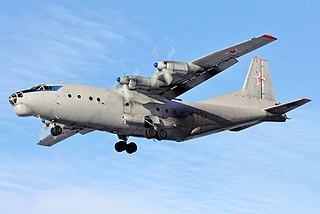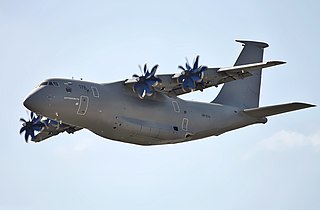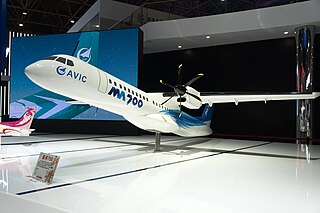Antonov Company, formerly the Aeronautical Scientific-Technical Complex named after Antonov, and earlier the Antonov Design Bureau, for its chief designer, Oleg Antonov, is a Ukrainian aircraft manufacturing and services company. Antonov's particular expertise is in the fields of very large aeroplanes and aeroplanes using unprepared runways. Antonov has built a total of approximately 22,000 aircraft, and thousands of its planes are operating in the former Soviet Union and in developing countries.

The Antonov An-22 "Antei" is a heavy military transport aircraft designed by the Antonov Design Bureau in the Soviet Union. Powered by four turboprop engines each driving a pair of contra-rotating propellers, the design was the first wide-body transport aircraft and remains the world's largest turboprop-powered aircraft to date. The An-22 first appeared publicly outside the Soviet Union at the 1965 Paris Air Show. Thereafter, the model saw extensive use in major military and humanitarian airlifts for the Soviet Union, and is still in service with the Russian Aerospace Forces.

The Rolls-Royce AE 2100 is a turboprop developed by Allison Engine Company, now part of Rolls-Royce North America. The engine was originally known as the GMA 2100, when Allison was a division of former corporate parent General Motors.

The Antonov An-2 is a Soviet mass-produced single-engine biplane utility/agricultural aircraft designed and manufactured by the Antonov Design Bureau beginning in 1947. Its durability, high lifting power, and ability to take off and land from poor runways have given it a long service life. The An-2 was produced up to 2001 and remains in service with military and civilian operators around the world.

The Antonov An-24 is a 44-seat twin turboprop transport/passenger aircraft designed in 1957 in the Soviet Union by the Antonov Design Bureau and manufactured by Kyiv, Irkutsk and Ulan-Ude Aviation Factories.

The Antonov An-8 is a Soviet-designed twin-turboprop, high-wing light military transport aircraft.

The Antonov An-12 is a four-engined turboprop transport aircraft designed in the Soviet Union. It is the military version of the Antonov An-10 and has many variants. For more than three decades the An-12 was the standard medium-range cargo and paratroop transport aircraft of the Soviet air forces. A total of 1,248 were eventually built.

The Antonov An-28 is a twin-engined light turboprop transport aircraft, developed from the Antonov An-14M. It was the winner of a competition against the Beriev Be-30, for use by Aeroflot as a short-range airliner. It first flew in 1969. A total of 191 were built and 16 remain in airline service as at August 2015. After a short pre-production series built by Antonov, it was licence-built in Poland by PZL-Mielec. In 1993, PZL-Mielec developed its own improved variant, the PZL M28 Skytruck.

The Antonov An-32 is a turboprop twin-engined military transport aircraft. Its first flight was in July 1976 and displayed at the 1977 Paris Air Show. It is oriented towards flying in adverse weather conditions, and was produced from 1980 to 2012, and remains in service. It developed of the An-24, and the An-26 is related.

The Antonov An-70 is a four-engine medium-range transport aircraft, and the first aircraft to take flight powered only by propfan engines. It was developed in the late 1980s by the Antonov Design Bureau to replace the obsolete An-12 military transport aircraft. The maiden flight of the first prototype took place in December 1994 in Kyiv, now independent Ukraine. Within months the prototype had suffered a mid-air collision. A second airframe was produced to allow the flight-test programme to proceed. Both prototypes were produced by the Kyiv Aircraft Production Plant.

The Pratt & Whitney Canada PW100 aircraft engine family is a series of 1,800 to 5,000 shaft horsepower turboprops manufactured by Pratt & Whitney Canada. Pratt & Whitney Canada dominates the turboprops market with 89% of the turboprop regional airliner installed base in 2016, leading GE Aviation and Allison Engine Company.

The Antonov An-14 Pchelka or Pchyolka, Bdzhilka is a Soviet utility aircraft which was first flown on 15 March 1958. It was a twin-engined light STOL utility transport, with two 300 hp Ivchenko AI-14RF radial piston engines. Serial production started in 1966, and about 300 examples were built by the time production ended in 1972. The An-14 failed to replace the more successful An-2 biplane, which was manufactured until 1990,. The An-14's successor, the An-28 with turboprop engines, is still manufactured at PZL Mielec factories in Poland, under the names PZL M28 Skytruck and PZL M28B Bryza.

The Embraer EMB 121 Xingu is a twin-turboprop fixed-wing aircraft built by the Brazilian aircraft manufacturer, Embraer. The design is based on the EMB 110 Bandeirante, using its wing and engine design merged with an all-new fuselage. The EMB 121 first flew on 10 October 1976.

The Let L-410 Turbolet is a twin-engine short-range transport aircraft designed and produced by the Czech aircraft manufacturer Let Kunovice.

The PZL 130 Orlik is a Polish turboprop, single engine, two seat trainer aircraft.

The Lockheed L-100 Hercules is the civilian variant of the prolific C-130 Hercules military transport aircraft made by the Lockheed Corporation. Its first flight occurred in 1964. Longer L-100-20 and L-100-30 versions were developed. L-100 production ended in 1992 with 114 aircraft delivered. An updated variant of the model, LM-100J, has completed its first flight in Marietta, Georgia on 25 May 2017, and started production in 2019.

The Xi'an Y-7 is a twin turboprop transport/passenger aircraft built in China. It is based on the Soviet-designed Antonov An-24 series.

The PZL-106 Kruk is a Polish agricultural aircraft designed and built by WSK PZL Warszawa-Okęcie.

The Ilyushin Il-112/Il-212 is a high-wing light military transport aircraft being developed by Ilyushin Aviation Complex for air landing and airdrop of military air cargoes, equipment and personnel. The aircraft is manufactured by Voronezh Aircraft Production Association in Voronezh. In October 2023, according to a source inside the Russian industrial-military complex, it was reported that the Il-112 project will be redesigned and renamed into the Ilyushin Il-212, the main difference being that now the aircraft will be equipped with turbofan instead of turboprop.

The Xi'an MA700 is a twin-engine, medium-range turboprop airliner currently under development by Xi'an Aircraft Industrial Corporation of the Aviation Industry Corporation of China (AVIC).






















